Family : Ogcocephalidae

Text © Giuseppe Mazza

English translation by Mario Beltramini
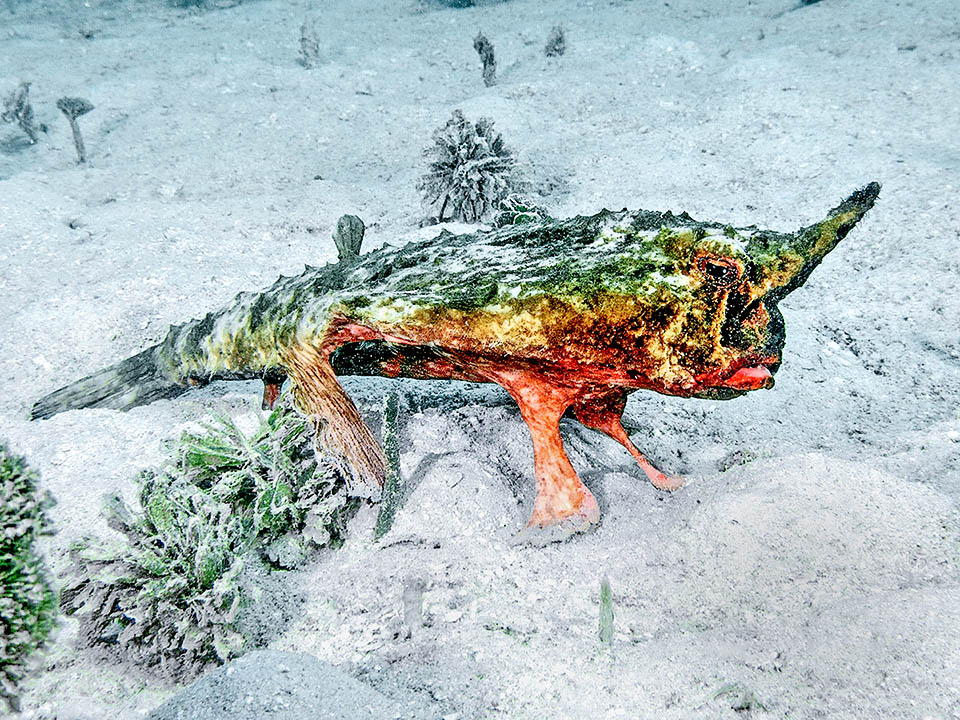
The Red belly batfish or Unicorn batfish (Ogcocephalus nasutus) can move with four legs on the seabeds up to 300 m of depth © Mickey Charteris
Ogcocephalus nasutus (Cuvier, 1829) belongs to the class of the Actinopterygii, the ray-finned fishes, and to the order of the Lophiiformes that gathers 18 families with species characterized, like the angler (Lophius piscatorius), by the presence on the head of an illicium, a sort of line with a lure to attract the preys.
It is part of the batfishes, inserted into the family of the Ogcocephalidae, counting 10 genera and 88 species present in the tropical and subtropical seas of all over the world, excepting the Mediterranean.
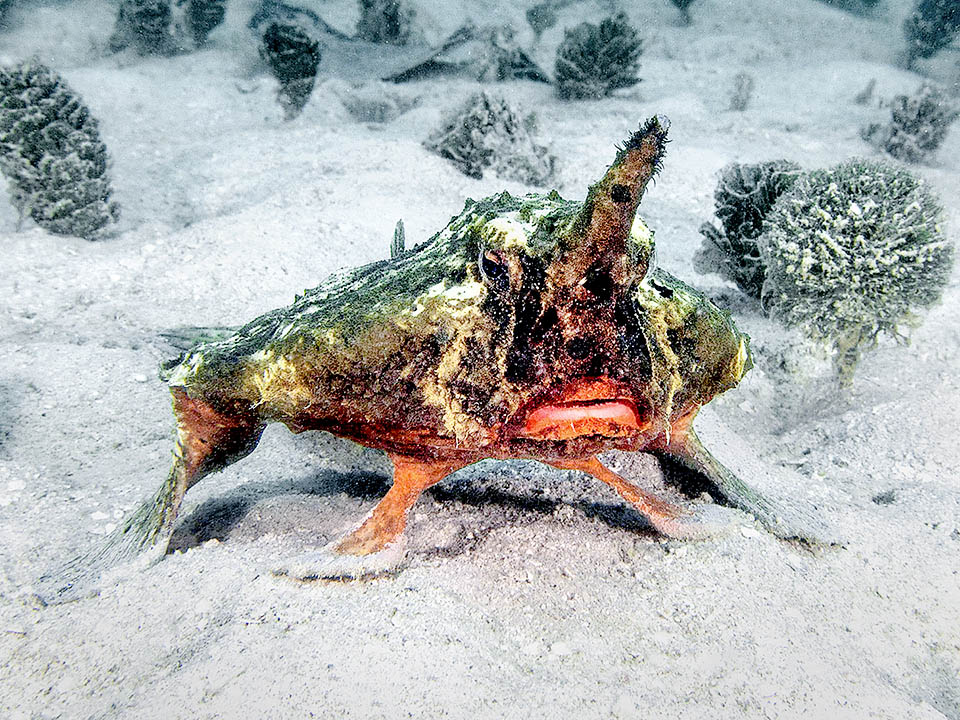
It lives in the Caribbean, from south-east Florida, Bahamas and the Gulf of Mexico to the north coasts of Brazil and Antilles © Mickey Charteris
Animals with ventrally flattened bodies walking on the seabeds with fins transformed in legs reaching even depths of 2000-4000 m.
Their illicium is tiny and gets out only when needed from a special lodge.
The name of the genus Ogcocephalus originates from the Greek “oγκος” (ogkos), hook, and “kεφαλή” (chefalò), head, rightly with reference to this tool, whilst the genus nasutus, with a big nose in Latin, evokes the extension of the head similar to a horn.
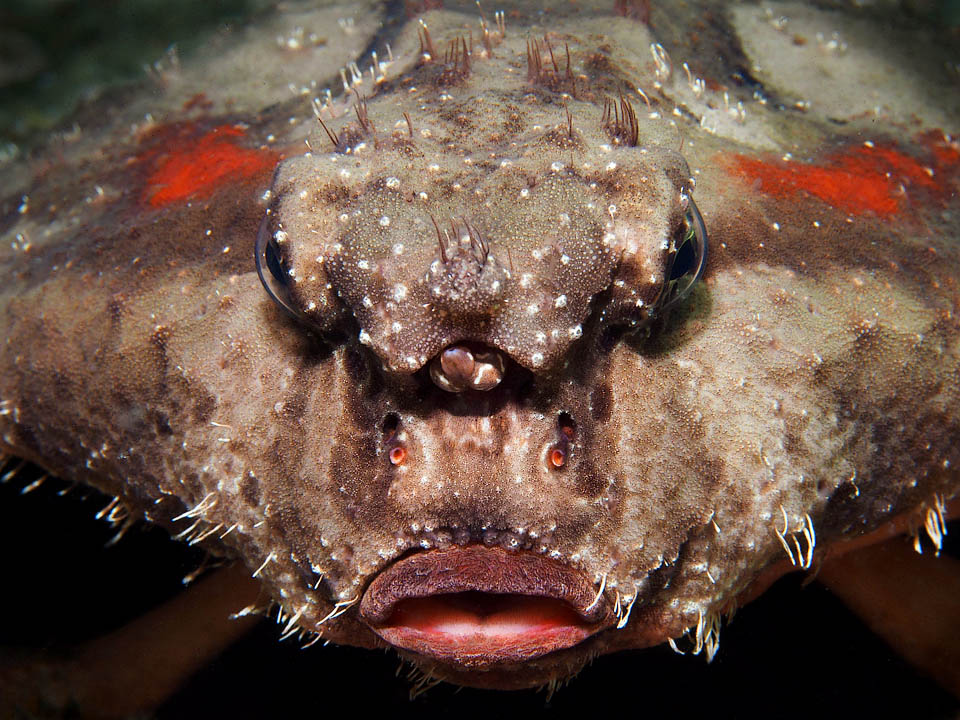
It belongs to Lophiiformes, they hunt with the illicium, a sort of a here tiny lure and visible in the centre of the photo with 3 roundish baits © Pauline Walsh Jacobson
Strangely enough, the English name of “Shortnose batfish”, states the opposite.
Better then, perhaps, the French name of “Poisson chauve-souris à ventre rouge”, that is Batfish having a red belly, but it is also called Unicorn batfish or Devilfish due to its disturbing shape, the dark back and the belly, red like flames of evil.
Zoogeography
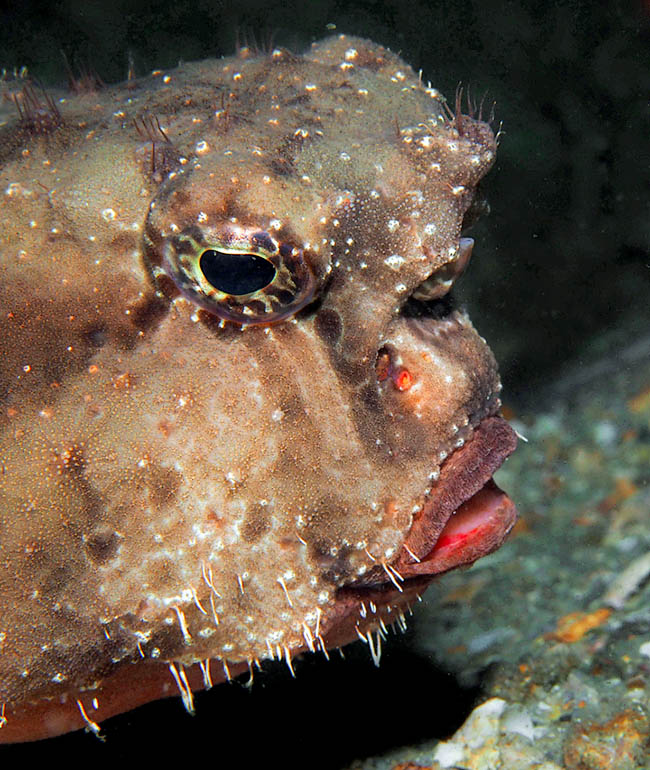
The wrinkly body of the fish is covered by conical scales, widened as a shield or thin and sharp with hairy look © Pauline Walsh Jacobson
Ogcocephalus nasutus is a fish of the Caribbean area, present from south-east Florida, Bahamas and the Gulf of Mexico, up to the northern coasts of Brazil and Antilles.
Ecology-Habitat
It is a benthic species which has been observed swimming on the surface but that can go down up to 300 m of depth.
It is often found partially covered by sand among the rubble of the corals along the edge of the reef, but also frequents the submerged prairies of phanerogams and the muddy bottoms where it stands waiting, motionless, the preys.
Morphophysiology
Ogcocephalus nasutus reaches even the length of 38 cm.
Seen from above, the front part of the fish has an unusual triangular profile, but what amazes the most are the pectoral fins detached from the body and transformed into limbs, complete with elbows and fleshy pads at the ends.
Leaning on them and on the pelvic, having similar look, the fish can even stand upright on the seabed and move like a four-legged animal, but can also swim for short distances, almost leaping, shaking wildly the pectoral fins and especially the caudal.
In some individuals the horn, facing mostly upwards, can also look down, and its length, quite variable, is sometimes modest.
Under this protuberance, just above the nostrils, is present the niche protecting its small illicium that has three tiny roundish baits.
It is assumed that its movement serves, like in the case of Antennarius multiocellatus, a Lophiiformes belonging to the family Antennariidae, to get closer, arousing the curiosity of passing preys, but it seems it has never been seen in action, even if it is a fish that can be observed by the divers and and even be grabbed with the hands.
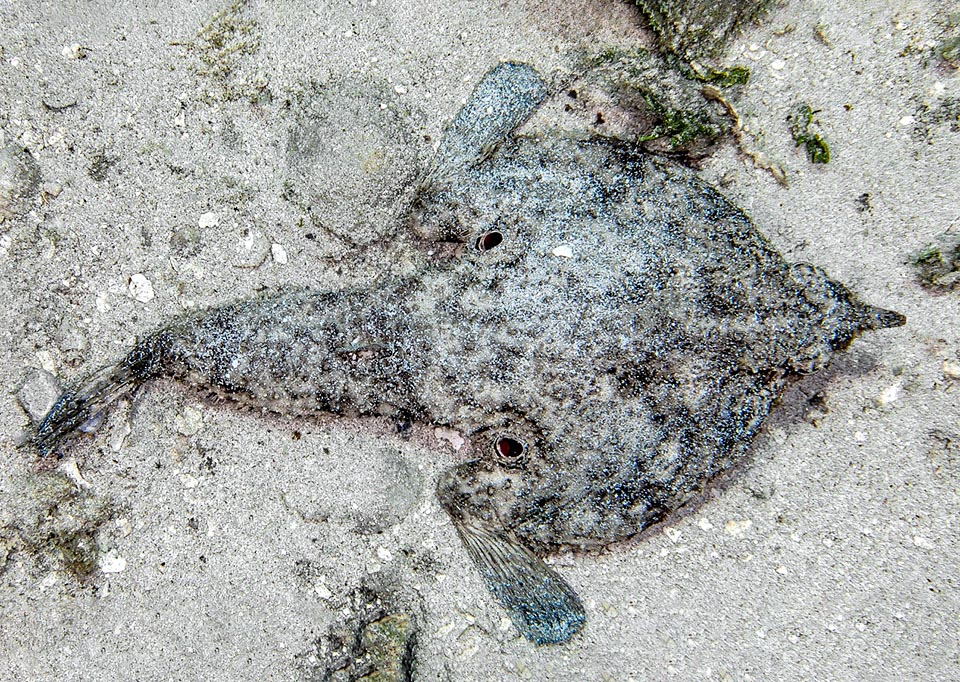
Seen from above the profile of the front part of the body is triangular. Here we note very well the tube-shaped opening gills at the base of the pectoral fins © Allison & Carlos Estape
In an aquarium it instinctively shakes its illicium as soon as a new fish is introduced, perhaps because it smells the newcomer.
But things stop here, also because in captivity it is probably used to the fragments of fish or shrimp that are offered.
to him.
The mouth of Ogcocephalus nasutus, low and of moderate size, is practically horizontal with tiny conical teeth arranged in bands on the jaws, but opens almost circular when it is bent outwards for seizing the preys.
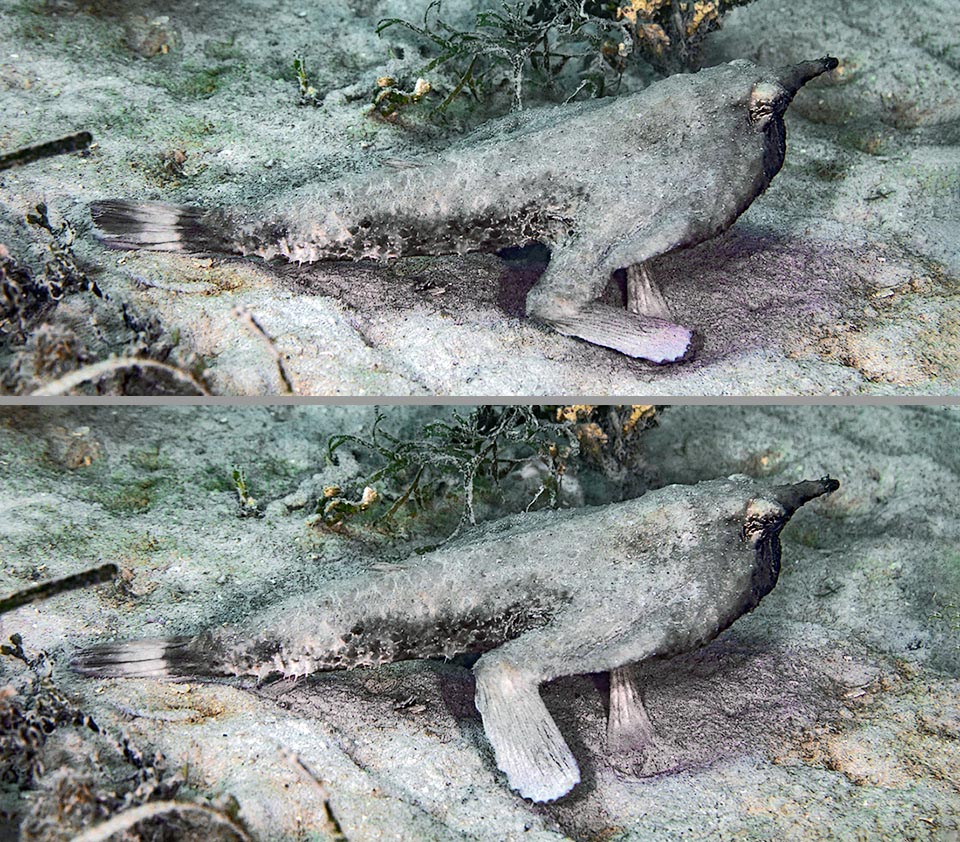
Sequence showing the movement of the pectoral fin transformed into a limb with evident elbow and flesh pads at the extremity © Allison & Carlos Estape
The small tube shaped opening gills, fitted with an operculum, are placed at the base of the pectoral fins and the gill rakers have oval plates having small teeth.
There is a modest dorsal fin with 4 unarmed rays towards the tail and the anal fin, of analogous size, mostly has 4 rays as well.
The body and the head are rough to the touch.
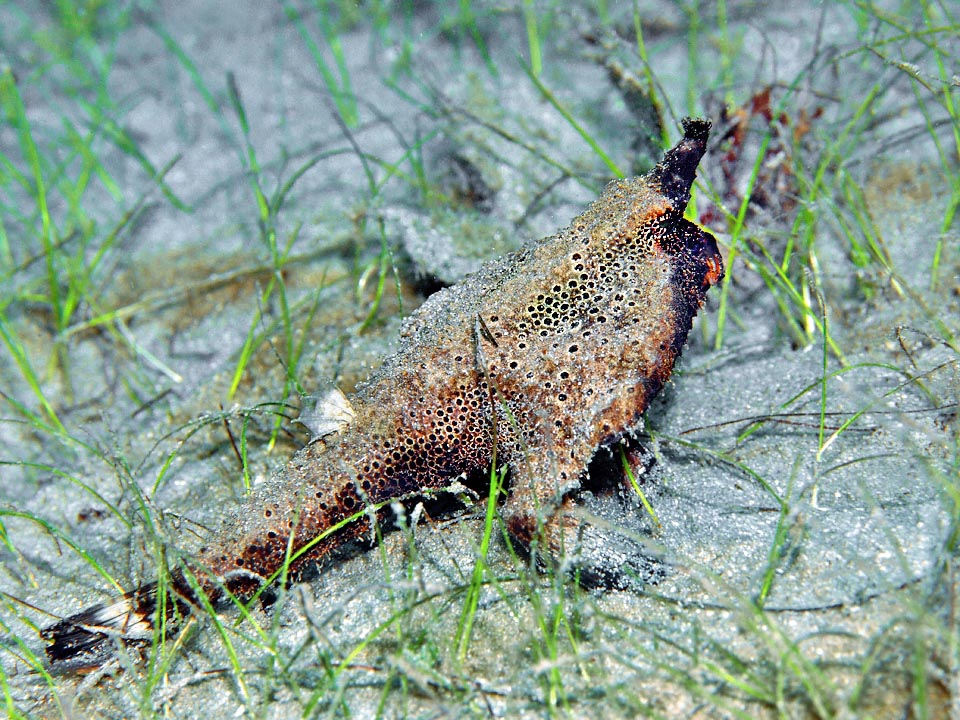
The greyish or reddish brown livery can be uniform or presenting a network design formed like here by dark light-edged spots © Pauline Walsh Jacobson
As a matter of fact, the upper part displays conical or widened as a shield scales, widened like a shield, whilst on the lower one we note sharp scales and small stings under the tail that at times has a longitudinal row of conical spines. Some thin pricklinesses, well visible on the horn, the chin and close to the eyes, have a hairy appearance.
The lateral line is formed by boat-shaped scales with a hole to collect information from the surrounding water. There are 7 to 8 of them under the operculum, 3 over the upper jaw and 9 on the cheek.
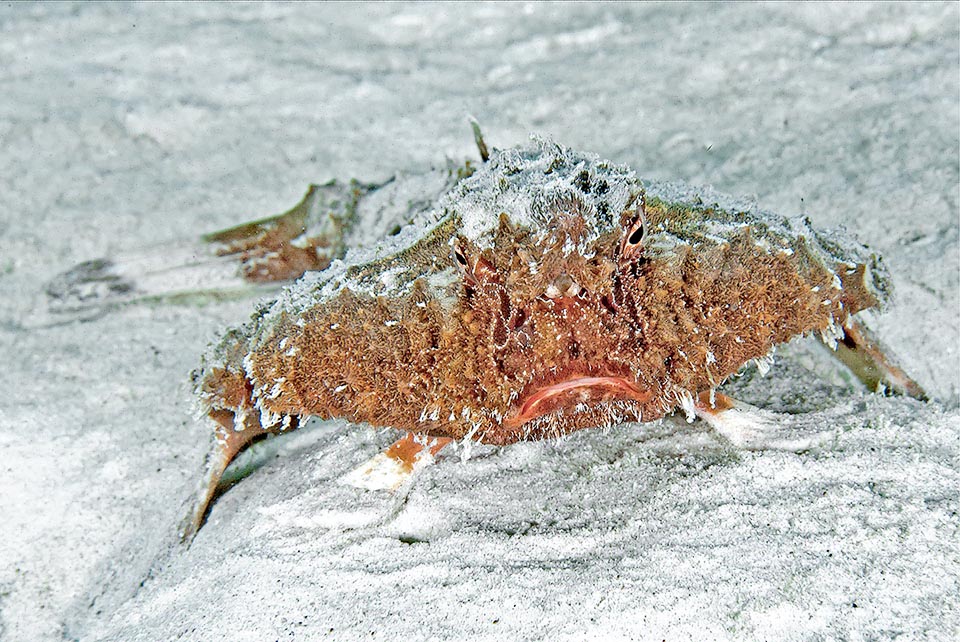
Ogcocephalus nasutus feeds on small fishes, crustaceans, mollusks and polychaete worms, integrating the carnivorous diet with small fragments of algae and phanerogams © Jim Greenfield
The colour of the dorsal side varies from blackish to grey or reddish brown. It may be uniform or presenting a network drawing made by dark light-edged spots.
The final part of the pectoral fins is black, as well as the caudal that, however, has then a clear zone in the middle with another black band towards the peduncle.
The lips, like the ventral side and the anal fin, are usually red.
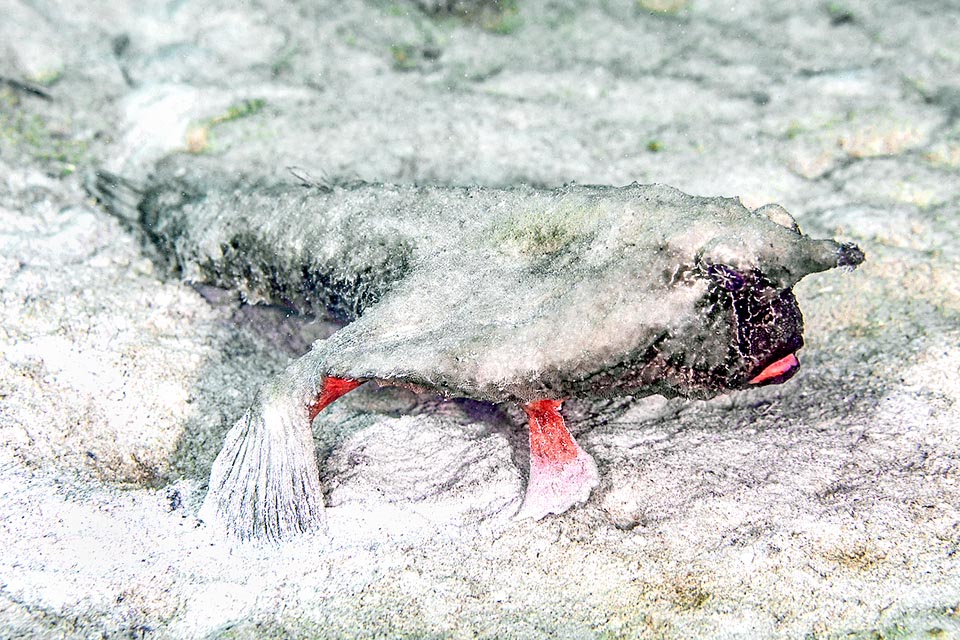
Often covers with sand or mud to surprise the preys and escape the gaze of the predators © Allison & Carlos Estape
Ethology-Reproductive Biology
Ogcocephalus nasutus feeds on small fishes, crabs, stomatopods, gastropods, bivalves and polychaete worms, integrating this carnivorous diet with fragments of algae and phanerogams.
It is presumed that it hunts in ambush, partially hidden by the sand and that this camouflaging serves also to protect it from the gaze of the predators.
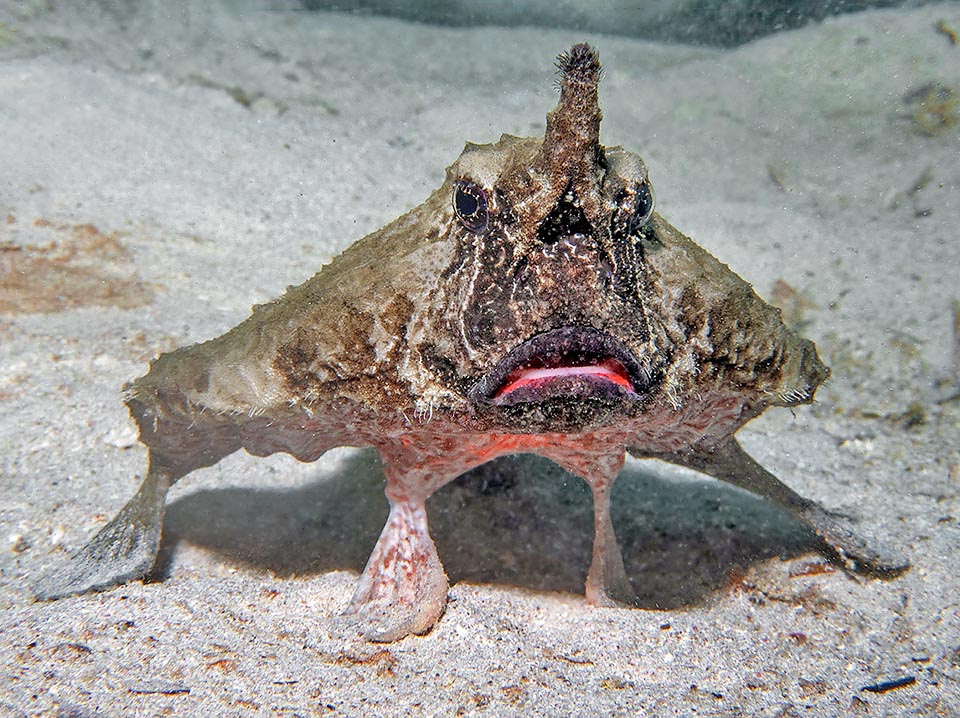
The reproductive modalities are still poorly known. The eggs are pelagic and the larvae metamorphose only when they reach the bottoms © Mickey Charteris
A similar species, Ogcocephalus vespertilio, also this one with the horn, has been seen using it for rummaging in the sand looking for preys while sucking up sand with the mouth filtering it with its gills.
The eggs of Ogcocephalus nasutus are pelagic and the larvae metamorphose only when they reach the bottoms.
The juveniles, similar to the adults with a small horn, have a mimetic livery that simulates the gravelly sand thanks to a light grating on dark background.
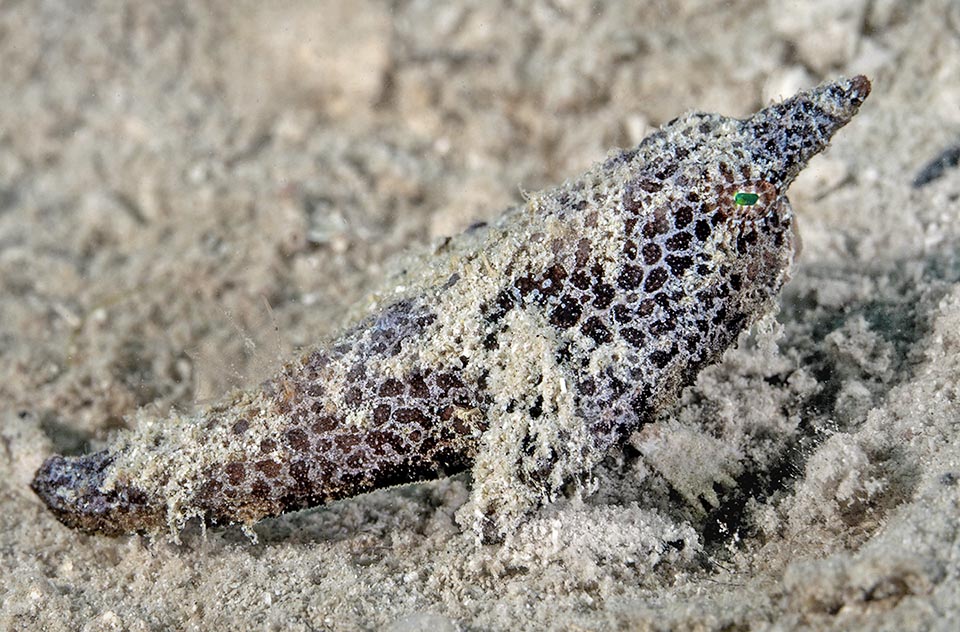
Juveniles, similar to adults with a small horn have a mimetic livery that simulates the gravelly sand thanks to a pale network on dark background © Mickey Charteris
The resilience of the species is low, as are needed 4,5-14 years for doubling the populations, but the fishing vulnerability is relatively low marking 28 on a scale of 100. In fact when it runs into the trawl nets, it is, if still alive, thrown back to the sea because it has no food or commercial value, unless ending up in some aquarium.
Thus, Ogcocephalus nasutus appears since 2014 as “LC, Least Concern” in the IUCN Red List of the endangered species.
Synonyms
Malthe nasuta Cuvier, 1829.
→ For general information about FISH please click here.
→ For general information about BONY FISH please click here
→ For general information about CARTILAGINOUS FISH please click here.
→ To appreciate the BIODIVERSITY of BONY FISH please click here.
→ To appreciate the BIODIVERSITY of CARTILAGINOUS FISH please click here.
